Table of Contents
Overview
This chapter provides a backdrop to the entire book. The end of the Cold War is usually seen as the beginning of the contemporary era in world politics which is the subject matter of this book. It is, therefore, appropriate that we begin the story with a discussion of the Cold War. The chapter shows how the dominance of two superpowers, the United States of America and the Soviet Union, was central to the Cold War. It tracks the various arenas of the Cold War in different parts of the world. The chapter views the Non-Aligned Movement (NAM) as a challenge to the dominance of the two superpowers and describes the attempts by the non-aligned countries to establish a New International Economic Order (NIEO) as a means of attaining economic development and political independence. It concludes with an assessment of India’s role in NAM and asks how successful the policy of non-alignment has been in protecting India’s interests.
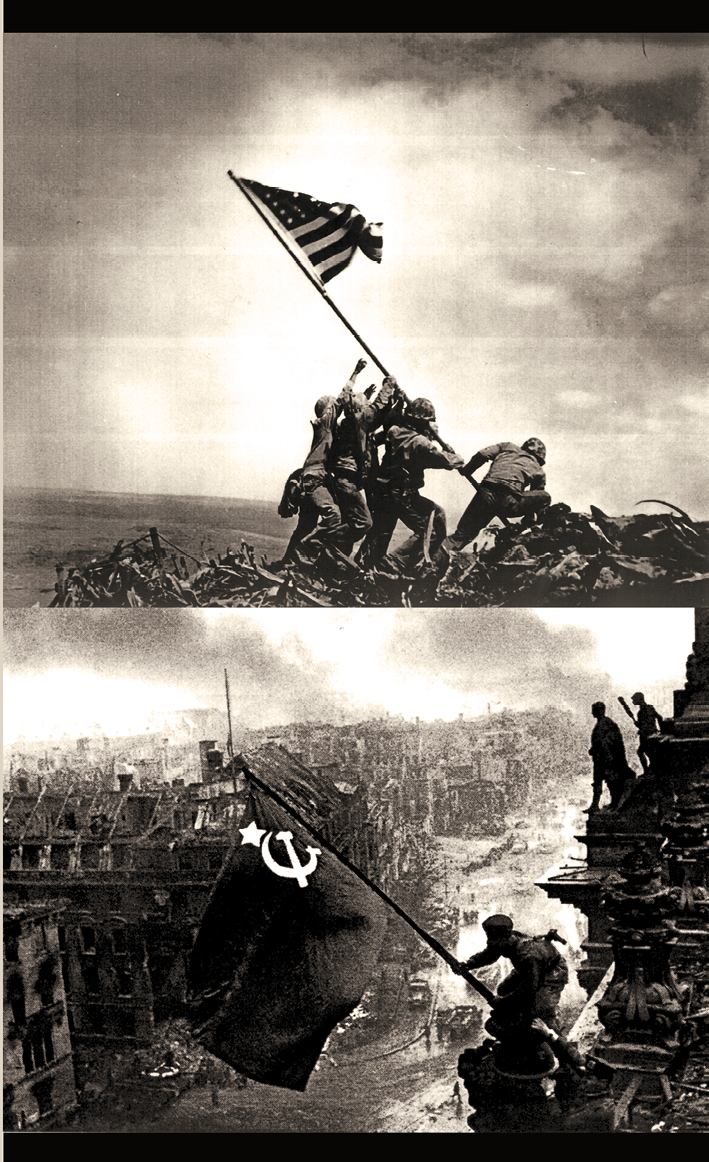
The end of the Second World War led to the rise of two major centres of power. The two pictures above symbolise the victory of the US and the USSR in the Second World War.
1. American soldiers raising the US flag during the Battle of Iwo Jima, Japan, on 23 February 1945
Credit: Raising the Flag on Iwo Jima, Photograph by Joe Rosenthal/The Associated Press
2. Soviet soldiers raising the USSR flag on the Reichstag building in Berlin, Germany, in May 1945
Credit: Reichstag flag, Photograph by Yevgeny Khaldei/TASS
The end of the Second World War led to the rise of two major centres of power. The two pictures above symbolise the victory of the US and the USSR in the Second World War. 1. American soldiers raising the US flag during the Battle of Iwo Jima, Japan, on 23 February 1945 Credit: Raising the Flag on Iwo Jima, Photograph by Joe Rosenthal/The Associated Press 2. Soviet soldiers raising the USSR flag on the Reichstag building in Berlin, Germany, in May 1945 Credit: Reichstag flag, Photograph by Yevgeny Khaldei/TASS
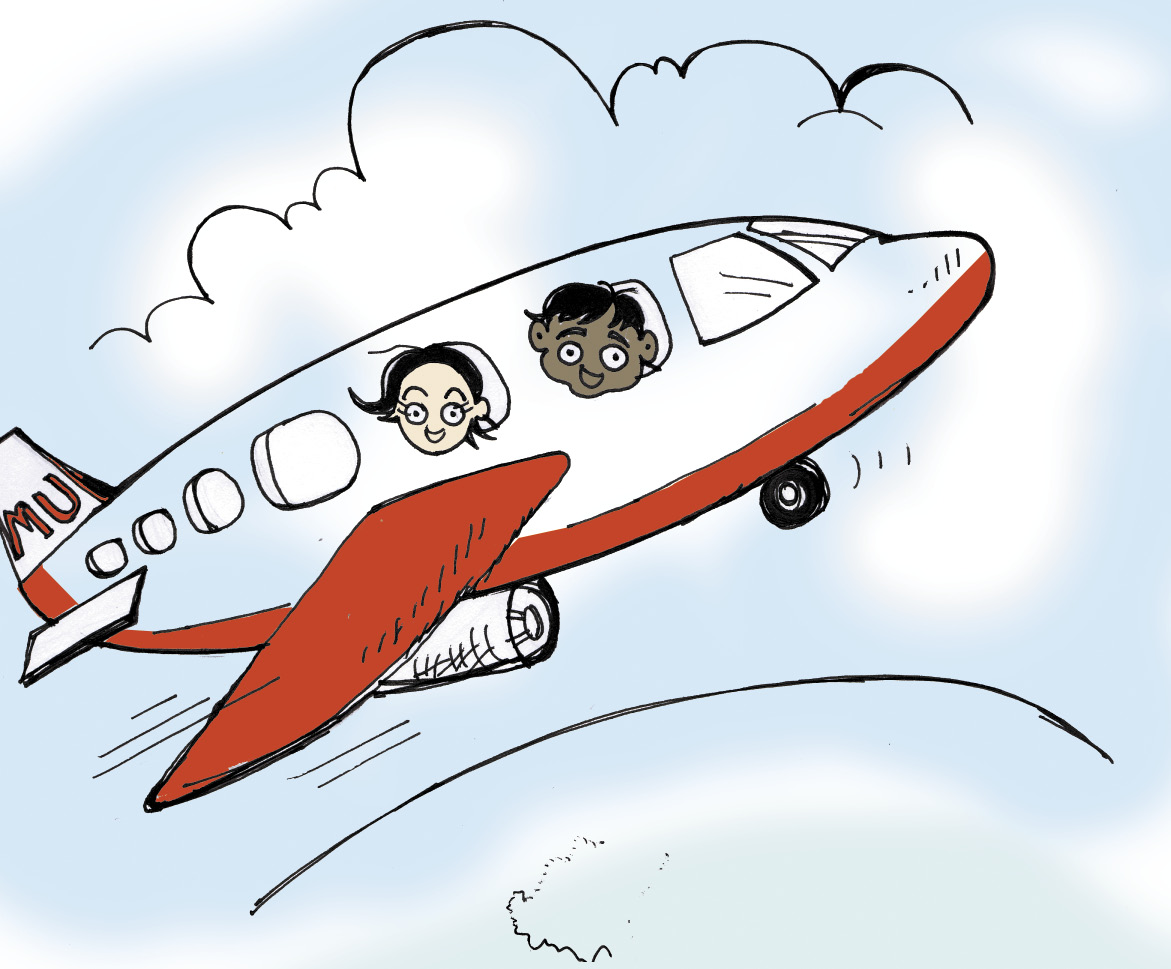
We are on a world tour! Will meet you in different countries. Feels good to be around where events have happened.
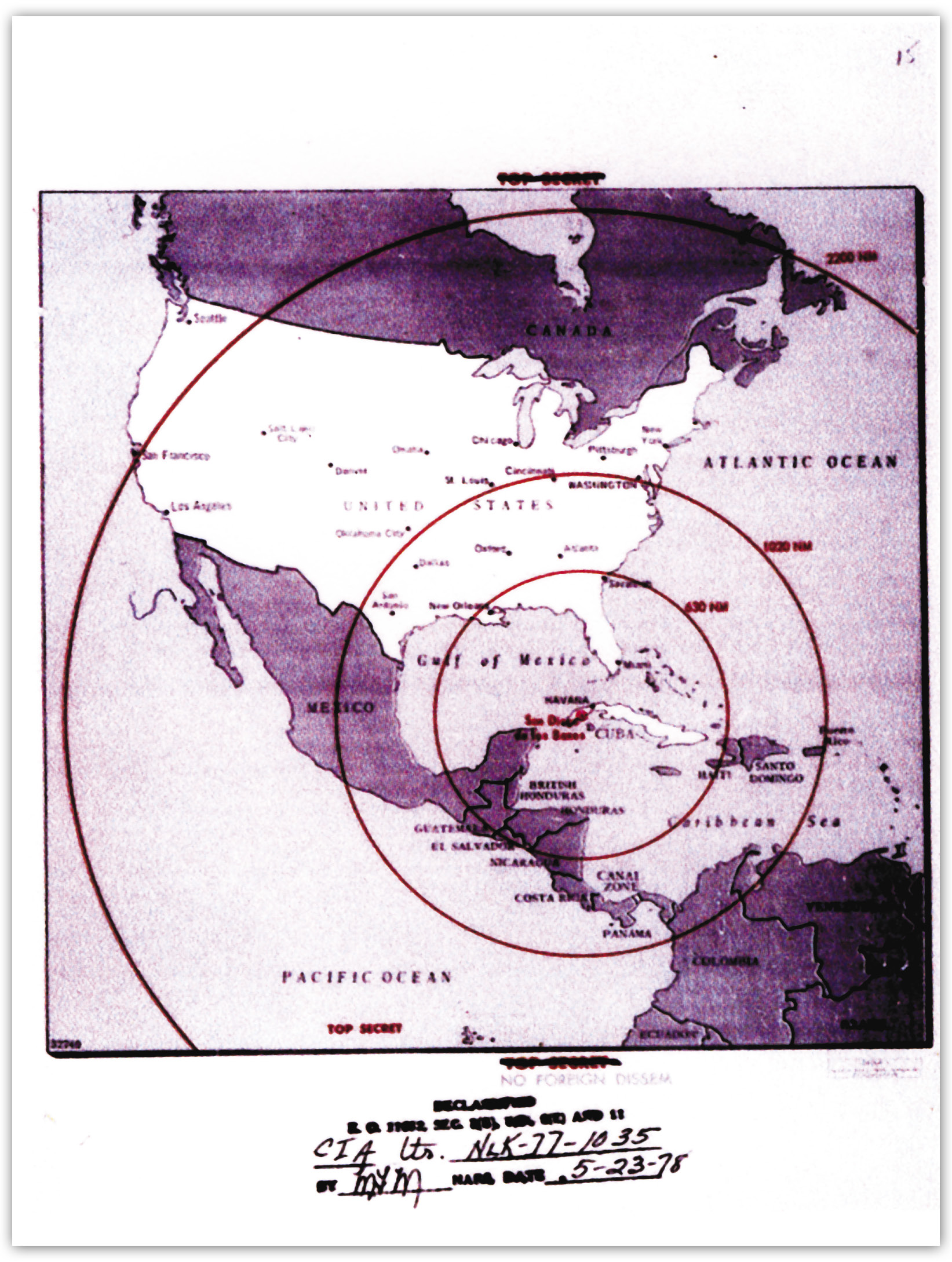
Map showing the range of the nuclear missiles under construction in Cuba, used during the secret meetings on the Cuban missile crisis
Cuban Missile Crisis
In April 1961, the leaders of the Union of Soviet Socialist Republics (USSR) were worried that the United States of America (USA) would invade communist-ruled Cuba and overthrow Fidel Castro, the president of the small island nation off the coast of the United States. Cuba was an ally of the Soviet Union and received both diplomatic and financial aid from it. Nikita Khrushchev, the leader of the Soviet Union, decided to convert Cuba into a Russian base. In 1962, he placed nuclear missiles in Cuba. The installation of these weapons put the US, for the first time, under fire from close range and nearly doubled the number of bases or cities in the American mainland which could be threatened by the USSR.
Three weeks after the Soviet Union had placed the nuclear weapons in Cuba, the Americans became aware of it. The US President, John F. Kennedy, and his advisers were reluctant to do anything that might lead to full-scale nuclear war between the two countries, but they were determined to get Khrushchev to remove the missiles and nuclear weapons from Cuba. Kennedy ordered American warships to intercept any Soviet ships heading to Cuba as a way of warning the USSR of his seriousness. A clash seemed imminent in what came to be known as the Cuban Missile Crisis. The prospects of this clash made the whole world nervous, for it would have been no ordinary war. Eventually, to the world’s great relief, both sides decided to avoid war. The Soviet ships slowed down and turned back.
The Cuban Missile Crisis was a high point of what came to be known as the Cold War. The Cold War referred to the competition, the tensions and a series of confrontations between the United States and Soviet Union, backed by their respective allies. Fortunately, however, it never escalated into a ‘hot war’, that is, a full-scale war between these two powers. There were wars in various regions, with the two powers and their allies involved in warfare and in supporting regional allies, but at least the world avoided another global war.
The Cold War was not simply a matter of power rivalries, of military alliances, and of the balance of power. These were accompanied by a real ideological conflict as well, a difference over the best and the most appropriate way of organising political, economic, and social life all over the world. The western alliance, headed by the US, represented the ideology of liberal democracy and capitalism while the eastern alliance, headed by the Soviet Union, was committed to the ideology of socialism and communism. You have already studied these ideologies in Class XI.
What is the Cold War?
The end of the Second World War is a landmark in contemporary world politics. In 1945, the Allied Forces, led by the US, Soviet Union, Britain and France defeated the Axis Powers led by Germany, Italy and Japan, ending the Second World War (1939-1945). The war had involved almost all the major powers of the world and spread out to regions outside Europe including Southeast Asia, China, Burma (now Myanmar) and parts of India’s northeast. The war devastated the world in terms of loss of human lives and civilian property. The First World War had earlier shaken the world between 1914 and 1918.

So near yet so far! I can’t believe that Cuba survived as a communist country for so long despite being located so close to the US. Just look at the map.
The end of the Second World War was also the beginning of the Cold War. The world war ended when the United States dropped two atomic bombs on the Japanese cities of Hiroshima and Nagasaki in August 1945, causing Japan to surrender. Critics of the US decision to drop the bombs have argued that the US knew that Japan was about to surrender and that it was unnecessary to drop the bombs.They suggest that the US action was intended to stop the Soviet Union from making military and political gains in Asia and elsewhere and to show Moscow that the United States was supreme. US supporters have argued that the dropping of the atomic bombs was necessary to end the war quickly and to stop further loss of American and Allied lives. Whatever the motives, the consequence of the end of the second world war was the rise of two new powers on the global stage. With the defeat of Germany and Japan, the devastation of Europe and in many other parts of the world, the United States and the Soviet Union became the greatest powers in the world with the ability to influence events anywhere on earth.
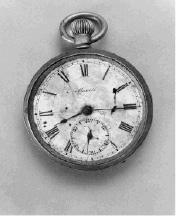
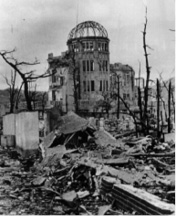
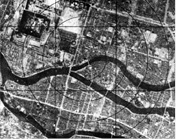
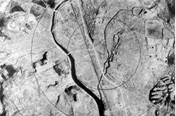

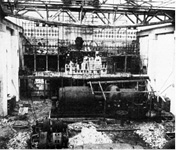
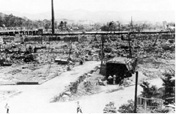
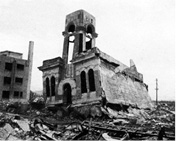
These pictures depict the destruction caused by the bombs dropped by the US on Hiroshima (the bomb was code-named ‘Little Boy’) and Nagasaki (code-named ‘Fat Man’). Yet, these bombs were very small in their destructive capacity (measured in terms of kiloton yield) as compared to the nuclear bombs that were to be available in the stockpiles assembled by the superpowers. The yield of Little Boy and Fat Man were 15 and 21 kilotons respectively. By the early 1950s the US and the USSR were already making thermonuclear weapons that had a yield between 10 and 15 thousand kilotons. In other words, these bombs were a thousand times more destructive than the bombs used in Hiroshima and Nagasaki. During much of the Cold War, both the superpowers possessed thousands of such weapons. Just imagine the extent of destruction that these could cause all over the globe.
In the event of a nuclear war, both sides will be so badly harmed that it will be impossible to declare one side or the other as the winneirr. Even if one of them tries to attack and disable the nuclear weapons of its rival, the other would still be left with enough nuclear weapons to inflict unacceptable destruction. This is called the logic of ‘deterrence’: both sides have the capacity to retaliate against an attack and to cause so much destruction that neither can afford to initiate war. Thus, the Cold War — in spite of being an intense form of rivalry between great powers — remained a ‘cold’ and not hot or shooting war. The deterrence relationship prevents war but not the rivalry between powers.
Note the main military features of the Cold War. The two superpowers and the countries in the rival blocs led by the superpowers were expected to behave as rational and responsible actors. They were to be rational and responsible in the sense that they understood the risks in fighting wars that might involve the two superpowers. When two superpowers and the blocs led by them are in a deterrence relationship, fighting wars will be massively destructive. Responsibility, therefore, meant being restrained and avoiding the risk of another world war. In this sense the Cold War managed to ensure human survival.
The Emergence of Two Power Blocs
The two superpowers were keen on expanding their spheres of influence in different parts of the world. In a world sharply divided between the two alliance systems, a state was supposed to remain tied to its protective superpower to limit the influence of the other superpower and its allies.
The smaller states in the alliances used the link to the superpowers for their own purposes. They got the promise of protection, weapons, and economic aid against their local rivals, mostly regional neighbours with whom they had rivalries. The alliance systems led by the two superpowers, therefore, threatened to divide the entire world into two camps. This division happened first in Europe. Most countries of western Europe sided with the US and those of eastern Europe joined the Soviet camp. That is why these were also called the ‘western’ and the ‘eastern’ alliances.
1. Identify three countries from each of the rival blocs.
2. Look at the map of the European Union in Chapter 4 and identify four countries that were part of the Warsaw Pact and now belong to the EU.
3. By comparing this map with that of the European Union map, identify three new countries that came up in the post-Cold War period.

Map showing the way Europe was divided into rival alliances during the Cold War
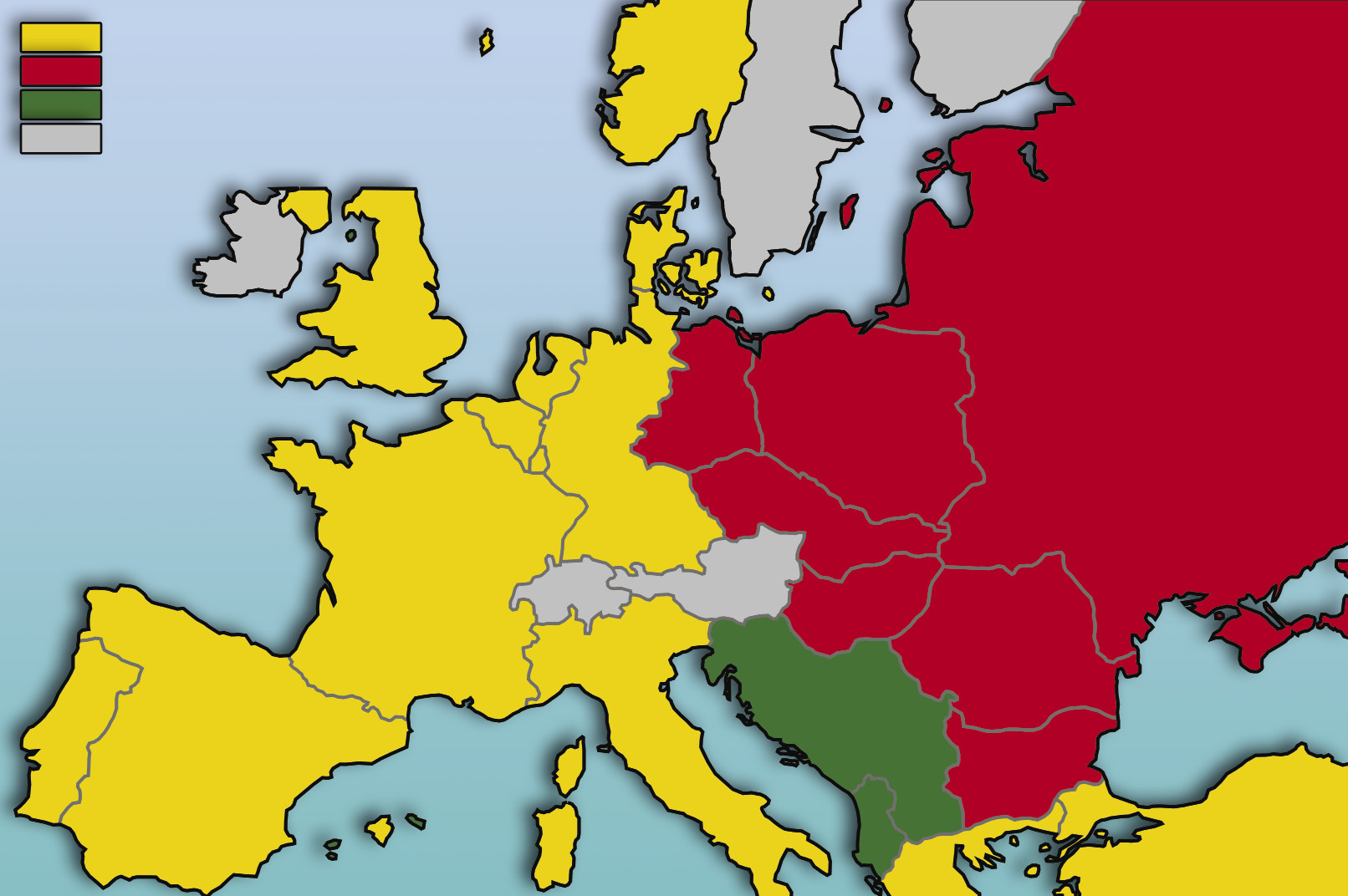
The western alliance was formalised into an organisation, the North Atlantic Treaty Organisation (NATO), which came into existence in April 1949. It was an association of twelve states which declared that armed attack on any one of them in Europe or North America would be regarded as an attack on all of them. Each of these states would be obliged to help the other. The eastern alliance, known as the Warsaw Pact, was led by the Soviet Union. It was created in 1955 and its principal function was to counter NATO’s forces in Europe.
In the following column, write the names of three countries, which belong to:
Capitalist Bloc
________________
________________
________________
communist Bloc
________________
________________
________________
Non-Aligned movement
________________
________________
________________
International alliances during the Cold War era were determined by the requirements of the superpowers and the calculations of the smaller states.As noted above, Europe became the main arena of conflict between the superpowers. In some cases, the superpowers used their military power to bring countries into their respective alliances. Soviet intervention in east Europe provides an example. The Soviet Union used its influence in eastern Europe, backed by the very large presence of its armies in the countries of the region, to ensure that the eastern half of Europe remained within its sphere of influence. In East and Southeast Asia and in West Asia (Middle East), the United States built an alliance system called — the Southeast Asian Treaty Organisation (SEATO) and the Central Treaty Organisation (CENTO). The Soviet Union and communist China responded by having close relations with regional countries such as North Vietnam, North Korea and Iraq.
The Cold War threatened to divide the world into two alliances. Under these circumstances, many of the newly independent countries, after gaining their independence from the colonial powers such as Britain and France, were worried that they would lose their freedom as soon as they gained formal independence. Cracks and splits within the alliances were quick to appear. Communist China quarrelled with the USSR towards the late 1950s, and, in 1969, they fought a brief war over a territorial dispute. The other important development was the Non-Aligned Movement (NAM), which gave the newly independent countries a way of staying out of the alliances.
You may ask why the superpowers needed any allies at all. After all, with their nuclear weapons and regular armies, they were so powerful that the combined power of most of the smaller states in Asia and Africa, and even in Europe, was no match to that of the superpowers. Yet, the smaller states were helpful for the superpowers in gaining access to
(i) vital resources, such as oil and minerals,
(ii) territory, from where the superpowers could launch their weapons and troops,
(iii) locations from where they could spy on each other, and
(iv) economic support, in that many small allies together could help pay for military expenses.
They were also important for ideological reasons. The loyalty of allies suggested that the superpowers were winning the war of ideas as well, that liberal democracy and capitalism were better than socialism and communism, or vice versa.
Arenas of the Cold War
The Cuban Missile Crisis that we began this chapter with was only one of the several crises that occurred during the Cold War. The Cold War also led to several shooting wars, but it is important to note that these crises and wars did not lead to another world war. The two superpowers were poised for direct confrontations in Korea (1950 - 53), Berlin (1958 - 62), the Congo (the early 1960s), and in several other places. Crises deepened, as neither of the parties involved was willing to back down. When we talk about arenas of the Cold War, we refer, therefore, to areas where crisis and war occurred or threatened to occur between the alliance systems but did not cross certain limits. A great many lives were lost in some of these arenas like Korea, Vietnam and Afghanistan, but the world was spared a nuclear war and global hostilities. In some cases, huge military build-ups were reported. In many cases, diplomatic communication between the superpowers could not be sustained and contributed to the misunderstandings.

How come there are still two Koreas while the other divisions created by the Cold War have ended? Do the people of Korea want the division to continue?
Lets Do It
Locate the flashpoints of the Cold War on a world map.
Sometimes, countries outside the two blocs, for example, the non-aligned countries, played a role in reducing Cold War conflicts and averting some grave crises. Jawaharlal Nehru — one of the key leaders of the NAM — played a crucial role in mediating between the two Koreas. In the Congo crisis, the UN Secretary-General played a key mediatory role. By and large, it was the realisation on a superpower’s part that war by all means should be avoided that made them exercise restraint and behave more responsibly in international affairs. As the Cold War rolled from one arena to another, the logic of restraint was increasingly evident.
The COld War TIMELINE
| 1947 | American President Harry Truman’s Doctrine about the containment of communism |
| 1947 - 52 | Marshall Plan: US aid for the reconstruction of the Western Europe |
| 1948 - 49 | Berlin blockade by the Soviet Union and the airlift of supplies to the citizens of West Berlin by the US and its allies |
| 1950 - 53 | Korean War; division of Korea along the 38th Parallel |
| 1954 | Defeat of the French by the Vietnamese at Dien Bien Phu Signing of the Geneva Accords Division of Vietnam along the 17th Parallel Formation of SEATO |
| 1954 - 75 | American intervention in Vietnam |
| 1955 | Signing of the Baghdad Pact, later CENTO |
| 1956 | Soviet intervention in Hungary |
| 1961 | US-sponsored Bay of Pigs invasion of Cuba Construction of the Berlin Wall |
| 1962 | Cuban Missile Crisis |
| 1965 | American intervention in the Dominican Republic |
| 1968 | Soviet intervention in Czechoslovakia |
| 1972 | US President Richard Nixon’s visit to China |
| 1978 - 89 | Vietnamese intervention in Cambodia |
| 1979 - 89 | Soviet intervention in Afghanistan |
| 1985 | Gorbachev becomes the President of the USSR; begins the reform process |
| 1989 | Fall of the Berlin Wall; mass protests against governments in eastern Europe |
| 1990 | Unification of Germany |
| 1991 | Disintegration of the Soviet Union End of the Cold War era |
However, since the Cold War did not eliminate rivalries between the two alliances, mutual suspicions led them to arm themselves to the teeth and to constantly prepare for war. Huge stocks of arms were considered necessary to prevent wars from taking place.
The two sides understood that war might occur in spite of restraint. Either side might miscalculate the number of weapons in the possession of the other side. They might misunderstand the intentions of the other side. Besides, what if there was a nuclear accident? What would happen if someone fired off a nuclear weapon by mistake or if a soldier mischievously shot off a weapon deliberately to start a war? What if an accident occurred with a nuclear weapon? How would the leaders of that country know it was an accident and not an act of sabotage by the enemy or that a missile had not landed from the other side?
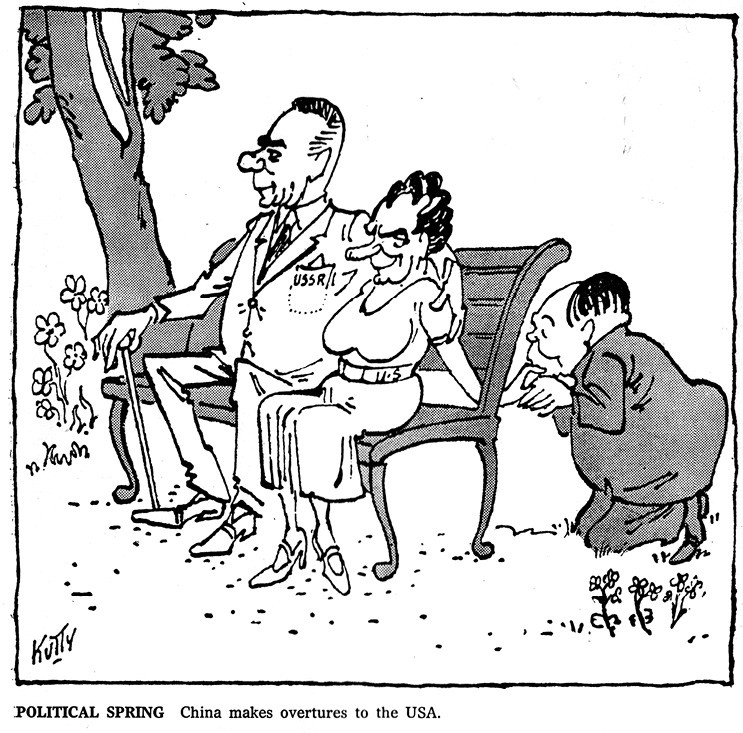
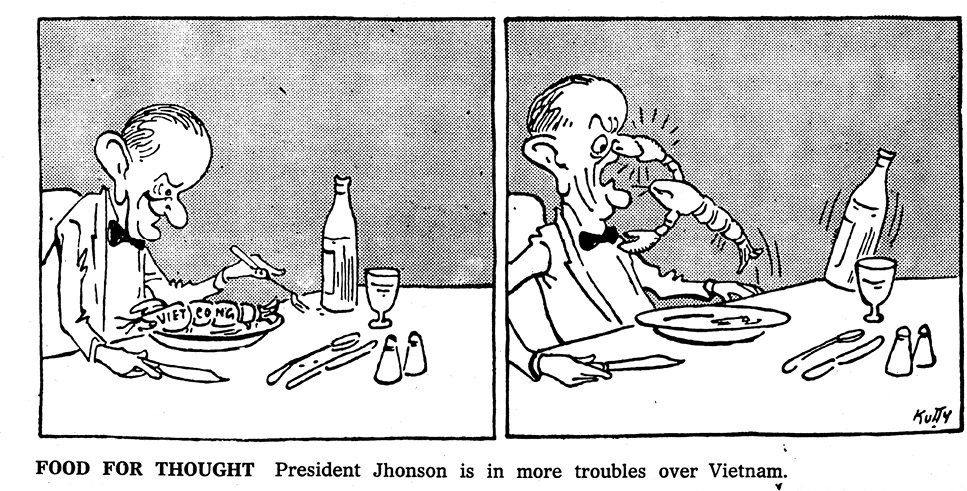
Drawn by well-known Indian cartoonist Kutty, these two cartoons depict an Indian view of the Cold War. The first cartoon was drawn when the US entered into a secret understanding with China, keeping the USSR in the dark. Find out more about the characters in the cartoon. The second cartoon depicts the American misadventure in Vietnam. Find out more about the Vietnam War.
POLITICAL SPRING China makes overtures to the USA.
In time, therefore, the US and USSR decided to collaborate in limiting or eliminating certain kinds of nuclear and non-nuclear weapons. A stable balance of weapons, they decided, could be maintained through ‘arms control’. Starting in the 1960s, the two sides signed three significant agreements within a decade. These were the Limited Test Ban Treaty, Nuclear Non-Proliferation Treaty and the Anti-Ballistic Missile Treaty. Thereafter, the superpowers held several rounds of arms limitation talks and signed several more treaties to limit their arms.
FOUNDER FIGURES OF NAM
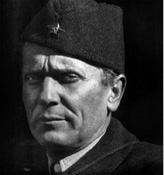
Josip Broz Tito (1892-1980)
President of Yugoslavia (1945-80); fought against Germany in World War II; communist; maintained some distance from the Soviet Union; forged unity in Yugoslavia.

Jawaharlal Nehru (1889-1964)
First Prime Minister of India (1947-64); made efforts for Asian unity, decolonisation, nuclear disarmament; advocated peaceful coexistence for securing world peace.
Challenge to Bipolarity
We have already seen how the Cold War tended to divide the world into two rival alliances. It was in this context that non-alignment offered the newly decolonised countries of Asia, Africa and Latin America a third option—not to join either alliance.
The roots of NAM went back to the friendship between three leaders — Yugoslavia’s Josip Broz Tito, India’s Jawaharlal Nehru, and Egypt’s leader Gamal Abdel Nasser — who held a meeting in 1956. Indonesia’s Sukarno and Ghana’s Kwame Nkrumah strongly supported them.
(i) cooperation among these five countries,
(ii) growing Cold War tensions and its widening arenas, and
(iii) the dramatic entry of many newly decolonised African countries into the inter-national arena. By 1960, there were 16 new African members in the UN.
The first summit was attended by 25 member states. Over the years, the membership of NAM has expanded. The latest meeting, the 17th summit, was held in Venezuela in 2016. It included 116 member states and 17 observer countries.
As non-alignment grew into a popular international movement, countries of various different political systems and interests joined it. This made the movement less homogeneous and also made it more difficult to define in very neat and precise terms: what did it really stand for? Increasingly, NAM was easier to define in terms of what it was not. It was not about being a member of an alliance.
The policy of staying away from alliances should not be considered isolationism or neutrality. Non-alignment is not isolationism since isolationism means remaining aloof from world affairs. Isolationism sums up the foreign policy of the US from the American War of Independence in 1787 up to the beginning of the First World War. In comparison, the non-aligned countries, including India, played an active role in mediating between the two rival alliances in the cause of peace and stability. Their strength was based on their unity and their resolve to remain non-aligned despite the attempt by the two superpowers to bring them into their alliances.
Non-alignment is also not neutrality. Neutrality refers principally to a policy of staying out of war. States practising neutrality are not required to help end a war. They do not get involved in wars and do not take any position on the appropriateness or morality of a war. Non-aligned states, including India, were actually involved in wars for various reasons. They also worked to prevent war between others and tried to end wars that had broken out.
New International Economic Order
The non-aligned countries were more than merely mediators during the Cold War. The challenge for most of the non-aligned countries — a majority of them were categorised as the Least Developed Countries (LDCs) — was to be more developed economically and to lift their people out of poverty. Economic development was also vital for the independence of the new countries. Without sustained development, a country could not be truly free. It would remain dependent on the richer countries including the colonial powers from which political freedom had been achieved.
The idea of a New Inter-national Economic Order (NIEO) originated with this realisation. The United Nations Conference on Trade and Development (UNCTAD) brought out a report in 1972 entitled Towards a New Trade Policy for Development. The report proposed a reform of the global trading system so as to:
(i) give the LDCs control over their natural resources exploited by the developed Western countries,
(ii) obtain access to Western markets so that the LDCs could sell their products and, therefore, make trade more beneficial for the poorer countries,
(iii) reduce the cost of technology from the Western countries, and
(iv) provide the LDCs with a greater role in international economic institutions.
Founder Figures of NAM
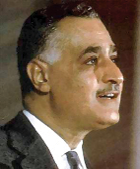

Sukarno (1901-70)
First President of Indonesia (1945-65); led the freedom struggle; espoused the causes of socialism and anti-imperialism; organised the Bandung Conference; overthrown in a military coup.
These five leaders came to be known as the five founders of NAM. The first non-aligned summit was held in Belgrade in 1961. This was the culmination of at least three factors:
Gradually, the nature of non-alignment changed to give greater importance to economic issues. In 1961, at the first summit in Belgrade, economic issues had not been very important. By the mid-1970s, they had become the most important issues. As a result, NAM became an economic pressure group. By the late 1980s, however, the NIEO initiative had faded, mainly because of the stiff opposition from the developed countries who acted as a united group while the non-aligned countries struggled to maintain their unity in the face of this opposition.
India and the Cold War
As a leader of NAM, India’s response to the ongoing Cold War was two-fold: At one level, it took particular care in staying away from the two alliances. Second, it raised its voice against the newly decolonised countries becoming part of these alliances.India’s policy was neither negative nor passive. As Nehru reminded the world, non-alignment was not a policy of ‘fleeing away’. On the contrary, India was in favour of actively intervening in world affairs to soften Cold War rivalries. India tried to reduce the differences between the alliances and thereby prevent differences from escalating into a full-scale war. Indian diplomats and leaders were often used to communicate and mediate between Cold War rivals such as in the Korea War in the early 1950s.
FOUNDER FIGURES OF NAM
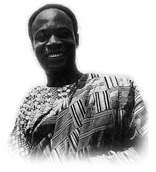
Kwame Nkrumah (1909-72)
First Prime Minister of Ghana (1952-66); led the freedom movement; advocated the causes of socialism and African unity; opposed neo-colonialism; removed in a military coup.
It is important to remember that India chose to involve other members of the non-aligned group in this mission. During the Cold War, India repeatedly tried to activate those regional and international organisations, which were not a part of the alliances led by the US and USSR. Nehru reposed great faith in ‘a genuine commonwealth of free and cooperating nations’ that would play a positive role in softening, if not ending, the Cold War.

So, NIEO was just an idea that never became an order. Right?
LET'S DO IT
Name any five countries, which were decolonised following the end of the Second World War.
Non-alignment was not, as some suggest, a noble international cause which had little to do with India’s real interests. A non-aligned posture also served India’s interests very directly, in at least two ways:
(i) First, non-alignment allowed India to take international decisions and stances that served its interests rather than the interests of the super-powers and their allies.
(ii) Second, India was often able to balance one superpower against the other. If India felt ignored or unduly pressurised by one superpower, it could tilt towards the other. Neither alliance system could take India for granted or bully it.
India’s policy of non-alignment was criticised on a number of counts. Here we may refer to only two criticisms:
(i) First, India’s non-alignment was said to be ‘unprincipled’. In the name of pursuing its national interest, India, it was said, often refused to take a firm stand on crucial international issues.
(ii) Second, it is suggested that India was inconsistent and took contradictory postures. Having criticised others for joining alliances, India signed the Treaty of Friendship in August 1971 with the USSR for 20 years. This was regarded, particularly by outside observers, as virtually joining the Soviet alliance system. The Indian government’s view was that India needed diplomatic and possibly military support during the Bangladesh crisis and that in any case the treaty did not stop India from having good relations with other countries including the US.
Non-alignment as a strategy evolved in the Cold War context. As we will see in Chapter 2, with the disintegration of the USSR and the end of the Cold War in 1991, non-alignment, both as an international movement and as the core of India’s foreign policy, lost some of its earlier relevance and effectiveness. However, non-alignment contained some core values and enduring ideas. It was based on a recognition that decolonised states share a historical affiliation and can become a powerful force if they come together. It meant that the poor and often very small countries of the world need not become followers of any of the big powers, that they could pursue an independent foreign policy. It was also based on a resolve to democratise the international system by thinking about an alternative world order to redress existing inequities. These core ideas remain relevant even after the Cold War has ended.
LET'S DO IT TOGETHER
Steps
Divide the classroom into three groups of even number. Each group is to represent three different worlds - first world/capitalist world, second world/communist world and the third world/non-aligned world.
The teacher is to select any two critical issues which posed a threat to world peace and security during the Cold War days. ( The Korean and Vietnam Wars would be good examples).
Assign each group to work on developing an ‘event profile’. They have to develop, from the vantage point of the bloc they represent, a presentation that contains a timeline of the event, its causes, their preferred course of action to solve the problem.
Each group is to present their event profile before the class.
Ideas for the Teacher
Draw students’ attention to the repercussions these crises had on the rest of the world and on the respective countries. Connect to the present situation in these countries.
Highlight the role played by the leaders of the Third World (India’s stand and contribution in Korea and Vietnam could be taken up for reference) and the UN to bring back peace in these regions.
Open a debate on ‘how we could avert these kind of crises’ in the post-Cold War world.
Arms Control Treaties
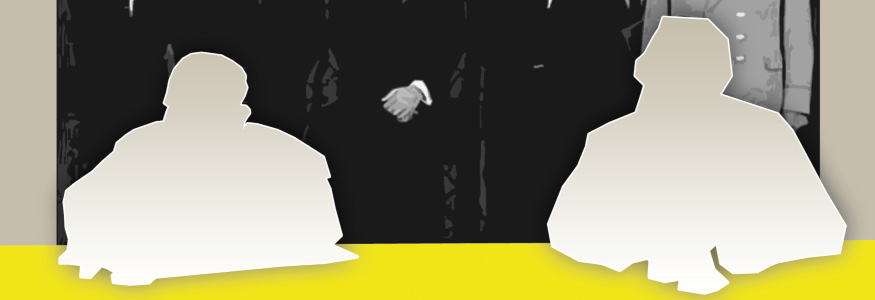
Limited Test Ban Treaty (LTBT)
Banned nuclear weapon tests in the atmosphere, in outer space and under water.
Signed by the US, UK and USSR in Moscow on 5 August 1963. Entered into force on 10 October 1963.
Nuclear Non-Proliferation Treaty (NPT)
Allows only the nuclear weapon states to have nuclear weapons and stops others from aquiring them. For the purposes of the NPT, a nuclear weapon state is one which has manufactured and exploded a nuclear weapon or other nuclear explosive device prior to 1 January 1967. So there are five nuclear weapon states: US, USSR (later Russia), Britain, France and China. Signed in Washington, London, and Moscow on 1 July 1968. Entered into force on 5 March 1970. Extended indefinitely in 1995.
Strategic Arms Limitation Talks I (SALT-I)
The first round of the Strategic Arms Limitation Talks began in November 1969. The Soviet leader Leonid Brezhnev and the US President Richard Nixon signed the following in Moscow on 26 May 1972 – a) Treaty on the limitation of Anti-Ballistic Missile Systems (ABM Treaty); and b) Interim Agreement on the limitation of strategic offensive arms. Entered into force on 3 October 1972.
Strategic Arms Limitation Talks ii (SALT-II)
The second round started in November 1972. The US President Jimmy Carter and the Soviet leader Leonid Brezhnev signed the Treaty on the limitation of strategic offensive arms in Vienna on 18 June 1979.
Strategic Arms Reduction Treaty I (START-I)
Treaty signed by the USSR President Mikhail Gorbachev and the US President George Bush (Senior) on the reduction and limitation of strategic offensive arms in Moscow on 31 July 1991.
Strategic Arms Reduction Treaty II (START-II)
Treaty signed by the Russian President Boris Yeltsin and the US President George Bush (Senior) on the reduction and limitation of strategic offensive arms in Moscow on 3 January 1993.
EXERCISES
1. Which among the following statements about the Cold War is wrong?
a) It was a competition between the US and Soviet Union and their respective allies.
b) It was an ideological war between the superpowers.
c) It triggered off an arms race.
d) the US and USSR were engaged in direct wars.
2. Which among the following statements does not reflect the objectives of NAM
a) Enabling newly decolonised countries to pursue independent policies
b) No to joining any military alliances
c) Following a policy of ‘neutrality’ on global issues
d) Focus on elimination of global economic inequalities
3. Mark correct or wrong against each of the following statements that describe the features of the military alliances formed by the superpowers.
a) Member countries of the alliance are to provide bases in their respective lands for the superpowers.
b) Member countries to support the superpower both in terms of ideology and military strategy.
c) When a nation attacks any member country, it is considered as an attack on all the member countries.
d) Superpowers assist all the member countries to develop their own nuclear weapons.
4. Here is a list of countries. Write against each of these the bloc they belonged to during the Cold War.
a) Poland
b) France
c) Japan
d) Nigeria
e) North Korea
f) Sri Lanka
5. The Cold War produced an arms race as well as arms control. What were the reasons for both these developments?
6. Why did the superpowers have military alliances with smaller countries? Give three reasons.
7. Sometimes it is said that the Cold War was a simple struggle for power and that ideology had nothing to do with it. Do you agree with this? Give one example to support your position.
8. What was India’s foreign policy towards the US and USSR during the Cold War era? Do you think that this policy helped India’s interests?
9. NAM was considered a ‘third option’ by Third World countries. How did this option benefit their growth during the peak of the Cold War?
10. What do you think about the statement that NAM has become irrelevant today. Give reasons to support your opinion.
